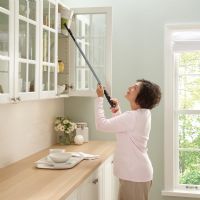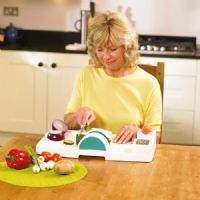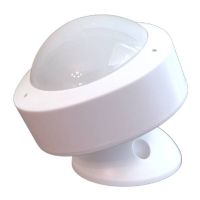 Written by Susan Griffitts, MSN, RN, FCN
Written by Susan Griffitts, MSN, RN, FCN
For so many people, the kitchen is a place of gathering filled with aromas that spark memories and joy. Unfortunately, for many others, it can also be a place of intimidation and danger, particularly for those aging in place. Aging in place is a term used to describe those that desire to remain in their homes as they age into older adulthood. And why shouldn’t they? According to a recent study completed by AARP, more than 77% of adults aged 50 and older want to remain in their homes for the long term. While for some this simply isn’t feasible, advancing technology and increased accessibility to safety information is making this desire a reality for many.
One of the most challenging aspects of aging in place is making sure the individual is both engaged and present, especially if isolation from the community and/or loved ones is occurring. Cooking and food are both powerful tools that bring engagement, sensation, and overall purpose to the person at home. Tastes and smells can elicit strong memories and bring about a sense of warmth and overall well-being. The kitchen is rightfully termed the heart of the home and creating a safe and systematic setup can keep that heartbeat strong.
.jpg&newwidth=365&maxheight=200) | Approach Height-Adjustable Frame Kits for Cabinets, Sinks, and Cooktops View Product |
When it comes to kitchen safety for the aging population, a few small changes can have a huge impact on cooking confidence and security. For those aging at home, setting your environment up for efficiency can greatly reduce the risk of falls and make cooking more organized and approachable. Start by decluttering your environment and setting down non-slip flooring to reduce those dreaded slips. Next, restructure your cabinets or counter space to put everyday objects within arm’s length versus relying on excessive overhead reach or ladder negotiation. Finally, enhance your visibility with easy-to-install under-cabinet lighting that enhances both safety and coordination during food prep. Cooking should be enjoyable yet streamlined and taking steps to reduce the overall physical tax of the activity will often improve confidence, compliance, and overall fall prevention.
Best: Approach Height-Adjustable Frame Kits for Cabinets, Sinks, and Cooktops
 | Full Handgrip Grabber Reacher Pick Up Tool for Disabled by Medline View Product |
Besides an ergonomic environment, adaptive kitchen tools can help with fall prevention as well as improve confidence and efficiency in the kitchen. With a marketplace full of adaptive equipment, seniors can find everything from grabber bars to easy-grip tools to cut-resistant gloves. If you can think of it, you can probably find it. Cooking doesn’t have to be a burden. Set yourself up with the right equipment and make day-to-day kitchen activities easier and safer.
Best: Full Handgrip Grabber Reacher Pick Up Tool for Disabled by Medline
The final and perhaps most important consideration for kitchen safety is preventing cooking-related injuries and emergencies. Cooking is the number one cause of home fires with adults aged 65 and above at the greatest risk of fire-related injury or death. Risk mitigation is key and small adjustments can go a long way towards preserving a loved one’s safety and quality of life. Consider incorporating auto-shutoff devices and keep workstations clear and accessible. Check your smoke alarms regularly and ensure that the senior has a fire extinguisher and fire exit strategy in place. For individuals who may be new to cooking after years of relying on a spouse to cook for them, consider providing some additional support, and don’t assume they know how to properly use all kitchen appliances.
Best: FireAvert Automatic Shut-Off Device for Stoves and Microwaves
 | Homecraft Kitchen Workstation One Handed Cutting Board View Product |
A number of common conditions can affect one’s ability to be successful in the kitchen. For starters, ask anyone with wrist or hand arthritis to open a tight jar and you may as well be asking them to solve a quadratic equation. Joint pain of any kind, but particularly from arthritis, can make cooking and kitchen negotiation very challenging. Luckily with ongoing product development, most individuals can maintain their cooking independence with kitchen aids that use leverage and technology to ease the burden of everyday tasks. Make small adjustments like incorporating lighter cookware, a lazy susan, or wider cabinet handles that can collectively ease the cooking and serving process and have a big impact on daily functioning.
Best: Homecraft Kitchen Workstation One Handed Cutting Board
 | Smart Sensor Senior Medical Alert System with Fall Detection | Elderly Monitoring with No Monthly Fee View Product |
Keeping track of where everything is in the kitchen and how best to use it can become increasingly difficult with age and particularly with dementia. While caregiver support may be necessary, utilizing things like labeling and storage containers can improve accessibility and remind the individual of proper use. Installing auto shutoff devices can be helpful with this population and limiting access to knives and other potentially dangerous objects can reduce the risk of injuries. In the case of emergencies, it’s important that the individual has a personal alert system or a patient monitor installed to notify caregivers of potentially dangerous situations. Although it can be challenging, bolstering the safety of your loved one should be the priority. It’s always better to err on the side of being overprotective and make adjustments as needed to ensure the individual’s safety and security are maintained.
Best: Smart Sensor Patient Monitoring Motion Detector by Smart Alert Tech
~42.jpg&newwidth=365&maxheight=200) | Hands-Free Task Light - Beam N Read Low Vision Lamp View Product |
In the case of low vision, decluttering and optimizing lighting will be key. With 18% of adults aged 65 years or older experiencing visual impairment, this population is not a small subset. Automatic night lights, under cabinet lighting, and task lamps are all great options for enhancing visibility around the home and particularly in the kitchen. Maintaining organized utensils, ingredients, and appliances will also improve safety and ease with food preparation and enhance confidence in kitchen navigation.
Best: Hands-Free Task Light - Beam N Read Low Vision Lamp
Finally, for those suffering from hearing loss, adaptive changes can be made to foster kitchen safety. Extra-loud timers and alarm clocks, phones, smoke alarms, and doorbells can all be helpful for maintaining environmental awareness and preventing emergencies from occurring.
Best: Clarity BT914 Amplified Bluetooth Phone
Kitchen safety is often a great concern for individuals with loved ones aging in place. Thankfully, with a well-designed environmental layout and adaptive equipment as needed, individuals can thrive in the kitchen and continue making memories for years to come.
For those looking for additional information and products designed to make aging in place accessible, check out Caregiver University and live your life with the independence and functionality you deserve.

After battling (and winning) cancer, Susan changed careers from being a paralegal to nursing. This decision was a direct result of the care received during her battle and all of her healthcare providers taking an interest in her as a person and not just a diagnosis. Thanks to those amazing experiences, this is the way Susan approaches nursing and caring for her patients. She is passionate about caring for all individuals but her primary focus is providing relief from the symptoms & stress of serious illnesses, the process of aging, and the particular problems of seniors.
Susan lost her right leg above the knee, to cancer, in 2013. Since that time, she has been very active in the amputee community helping to bring awareness and independence to other amputees. Read how Susan helped shape the future of new prosthetic devices.